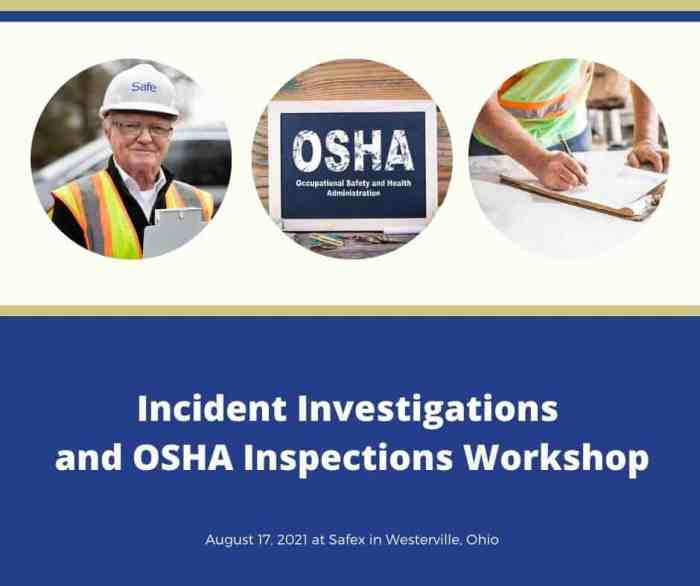An incident investigation osha 30 – Embark on an in-depth exploration of OSHA 30 Incident Investigation, a comprehensive approach to workplace safety that empowers organizations to prevent incidents, safeguard employees, and foster a culture of continuous improvement. This essential guide provides a structured framework for investigating incidents, identifying root causes, developing corrective actions, and communicating findings to enhance workplace safety and compliance.
Through a systematic and evidence-based approach, OSHA 30 empowers safety professionals to conduct thorough incident investigations, uncover underlying factors, and implement targeted interventions to prevent future occurrences. By embracing best practices and leveraging the guidance provided in this Artikel, organizations can create a safer and more productive work environment for all.
1. Introduction to OSHA 30 Incident Investigation
The Occupational Safety and Health Administration (OSHA) 30 Incident Investigation is a comprehensive process designed to identify the root causes of workplace incidents and develop effective corrective actions to prevent their recurrence. OSHA 30 provides a structured approach to incident investigation that emphasizes the importance of evidence gathering, root cause analysis, and corrective action development.
The OSHA 30 Incident Investigation process involves several key steps, including:
- Identifying and documenting evidence
- Analyzing incident root causes
- Developing corrective actions
- Communicating investigation findings and recommendations
- Implementing continuous improvement and best practices
2. Identifying and Documenting Evidence

Identifying and documenting evidence is crucial in OSHA 30 incident investigations. Evidence provides the foundation for understanding the sequence of events that led to the incident and identifying potential contributing factors.
Various methods can be used to gather evidence, including:
- Interviews with witnesses and involved parties
- Document reviews, such as safety manuals, training records, and maintenance logs
- Physical inspections of the incident scene, equipment, and materials
Proper documentation of evidence is essential to ensure its accuracy and integrity. This includes:
- Recording observations and statements accurately
- Taking photographs and videos to document the scene
- Preserving physical evidence for further analysis
3. Analyzing Incident Root Causes
Incident root causes refer to the underlying factors that contributed to the occurrence of an incident. Identifying root causes is essential to prevent similar incidents from happening in the future.
Different techniques can be used to analyze incident root causes, such as:
- Fault tree analysis: A logical diagram that identifies potential failure points and their relationships
- 5 Whys: A repetitive questioning technique that probes deeper into the underlying causes
Common root causes identified in OSHA 30 incident investigations include:
- Human factors, such as errors, lack of training, or fatigue
- Equipment failures or malfunctions
- Inadequate safety procedures or lack of enforcement
- Environmental factors, such as hazardous conditions or exposure to chemicals
4. Developing Corrective Actions
Developing corrective actions is a critical step in OSHA 30 incident investigations. Corrective actions aim to address the root causes identified and prevent similar incidents from occurring in the future.
The process of developing corrective actions involves:
- Identifying potential corrective actions based on the root cause analysis
- Prioritizing corrective actions based on their potential impact and feasibility
- Implementing corrective actions effectively and monitoring their implementation
Examples of effective corrective actions implemented in response to OSHA 30 incident investigations include:
- Revising safety procedures and training programs
- Upgrading or replacing equipment to meet safety standards
- Implementing engineering controls to eliminate hazards
- Enhancing employee safety awareness and engagement
5. Communicating Investigation Findings and Recommendations

Communicating investigation findings and recommendations is essential to ensure that the results of the investigation are effectively communicated to relevant stakeholders.
Different methods can be used to communicate investigation results, such as:
- Written reports: Formal documents that summarize the investigation findings, root cause analysis, and corrective actions
- Presentations: Oral presentations that convey the investigation results to management, employees, and other stakeholders
- Training sessions: Interactive sessions that educate employees on the incident and its implications for safety practices
OSHA 30 plays a vital role in ensuring that investigation findings and recommendations are implemented effectively by:
- Providing a framework for conducting thorough investigations
- Establishing guidelines for documenting and communicating investigation results
- Requiring employers to take appropriate corrective actions based on investigation findings
6. Continuous Improvement and Best Practices: An Incident Investigation Osha 30
Continuous improvement is essential in incident investigation practices. Regularly reviewing and updating investigation procedures helps ensure that they remain effective and responsive to changing workplace conditions.
Best practices for conducting effective OSHA 30 incident investigations include:
- Involving a multidisciplinary team with expertise in safety, operations, and human factors
- Using a structured approach to evidence gathering and analysis
- Conducting thorough root cause analysis to identify underlying factors
- Developing and implementing effective corrective actions
- Communicating investigation findings and recommendations clearly and effectively
Organizations that have successfully implemented best practices in their incident investigation programs have experienced significant improvements in safety performance and a reduction in incident rates.
Popular Questions
What is the significance of OSHA 30 in incident investigations?
OSHA 30 Incident Investigation provides a standardized framework for conducting thorough investigations, ensuring consistency and adherence to best practices in workplace safety.
How does OSHA 30 assist in identifying root causes of incidents?
OSHA 30 employs various techniques such as fault tree analysis and 5 Whys to uncover underlying factors and identify the root causes of incidents, enabling organizations to address systemic issues and prevent recurrence.
What is the role of corrective actions in OSHA 30 Incident Investigation?
Corrective actions are crucial in OSHA 30 Incident Investigation as they provide specific measures to address identified root causes, preventing similar incidents from occurring in the future.